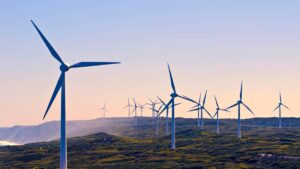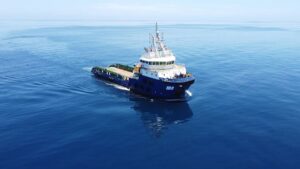Green Energy: This emissions-free autonomous ship is about to hit the water

Pic: Thana Prasongsin / Moment via Getty Images
World’s first autonomous, emissions free container ship to hit the water in Norway
Norse fertiliser producer Yara is hunting a landmark achievement this year, aiming to send the first zero-emission cargo ship off to sea this year.
If that doesn’t float your boat the Yara Birkeland will be autonomous too, capturing a couple of the major ESG and technology trends gripping heavy industries like mining and shipping these days.
The ship will make its maiden voyage by the end of 2021 after Covid halted its sailing last year on a 13km journey between the small Norwegian towns of Heroya and Brevik and monitored from three remote monitoring centres.
According to CNN, the $25 million vessel will be able to carry 103 containers at a top speed of 13 knots, boasting a 7MWh battery, equivalent to around 1000 passenger EVs.
While that is small in the context of the booming global shipping trade, Yara says the Birkeland could save up to 40,000 truck trips a year, reducing nitrous oxide and CO2 emissions and improve road safety in a densely populated urban area in Norway.
Shipping globally generates up to 3% of greenhouse gas emissions.
Virtually every container ship in the world is in use, chasing record freight rates on offer globally.
Capacity payments “a $1.3 billion saving”: ESB
The Energy Security Board finally released the details of its recommendations to state and federal Energy Ministers today.
Coalition Energy Minister Angus Taylor claims hotly-contested changes to introduce a physical capacity mechanism, the exact design of which the ESB says will only be worked out over the next 12-18 months, will save consumers $1.3 billion to keep physical capacity in the market.
That aspect of the post-2025 market reform has been criticised by clean energy companies and industry groups as an effective subsidy for coal and gas generators who would otherwise exit the market as cheaper renewable capacity priced them out.
What the ESB report itself says is this:
“There are potential benefits of a new capacity mechanism of $1.3 billion (NPV), when compared to adjusting the current market signals for capacity by raising the market price cap and increasing price volatility in the energy market.”
“This modelling suggests that, with reform (an appropriately designed capacity mechanism), it will be cheaper to deliver capacity under new market arrangements that reduce the uncertainty for investment in capacity. Without reform to the way that plants enter and exit the system to smooth the transition, there will be costs to consumers.
“The timely entry of generation to replace gaps in available capacity is also crucial to maintaining reliability. Further work will be undertaken on the costs and benefits associated with the new capacity mechanism as part of the proposed detailed design process.”
Taylor wrote in an opinion piece in News Corp’s Herald Sun this morning that the changes would avoid a repeat of price shocks seen when the Hazelwood power station closed in 2017.
“The problem we face is that investment in new dispatchable generation has been almost non-existent,” he wrote. “In fact, no new dispatchable generator has been built in NSW in the last 12 years or Victoria in the last eight.
“What makes the situation worse, we are now dealing with the prospect that existing dispatchable generation could leave the market much sooner than expected. Without sufficient like-for-like replacement, the risk this would present to Australian households and businesses would be severe.”
“We had a glimpse of what such a future would look like following the sudden closure of the Hazelwood power station in 2017, when electricity prices skyrocketed by up to 85 per cent in Victoria, 63 per cent in NSW and 53 per cent in QLD.”
Meridian gives a hint of Aussie exit strategy
How do renewable energy firms feel about the policy situation for green energy in Australia right now?
Not great, if the word of Kiwi power generator and retailer Meridian Energy (ASX:MEZ) is anything to go by.
Meridian has already flagged plans to to sell its Australian operations, and included this nugget in yesterday’s financials release.
“The strategic rationale for investing in renewable energy in Australia is still sound, and given that only around 30% of Australia’s electricity is generated by renewable sources, the potential for growth in renewables is large as Australia looks to decarbonise its economy,” they wrote.
“But the energy market in Australia is highly politicised, and government and regulatory interventions at both State and Federal levels are creating significant uncertainty for our business.”
“Accordingly, towards year end we announced we would be revisiting our growth strategy and our ownership of Meridian Energy Australia.”
“This review will consider a full range of options, including accelerated growth as well as partial or full divestment. The ownership review is expected to take a number of months and no decision will be made on the future direction of or options for Meridian Energy Australia until the completion of that process.”
Like other power providers, including thermal generators and majors like AGL and Origin, Meridian suffered from low wholesale prices, but also said Australia’s “dependence on fossil fuels is holding back the adoption of renewables”.
Meridian generated a net profit after tax of $428 million in 2021, up from $175m a year earlier, on EBITDAF of $729m.
However, its operating margins fell from $1.12 billion in New Zealand and $122m in Australia in 2020 to $994m and $97m respectively in 2021.
Meridian Energy share price today:
Related Topics
UNLOCK INSIGHTS
Discover the untold stories of emerging ASX stocks.
Daily news and expert analysis, it's free to subscribe.
By proceeding, you confirm you understand that we handle personal information in accordance with our Privacy Policy.








